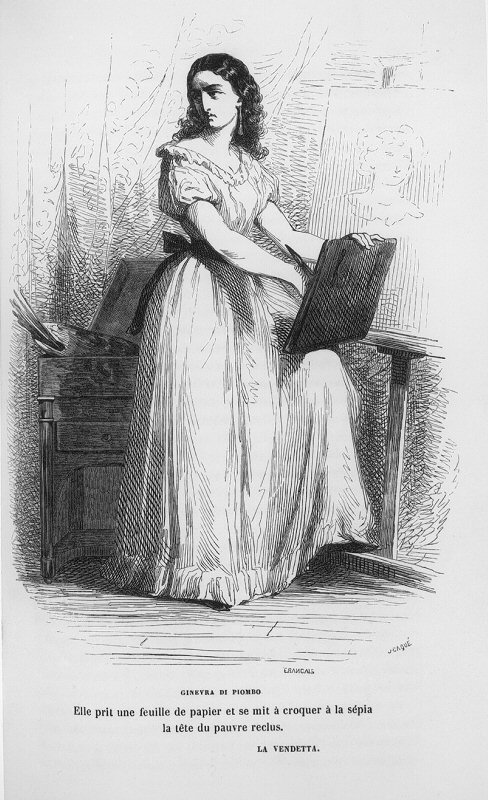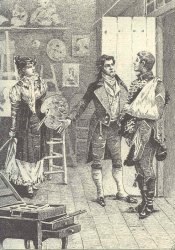
The Vendetta
THE HUMAN COMEDY – Honoré de Balzac First volume of works of Honoré de Balzac edited by widow André Houssiaux, publisher, Hebert and Co, successors, 7 rue Perronet – Paris (1877)
Scenes from private life

Ginevra
LA VENDETTA DEDICATED TO PUTTINATI, Milanese sculptor
Analysis and history La Vendetta is a short story that appeared in 1830 at the head of Volume I of Scènes de la vie privée, which marked the start of Balzac’s literary success. Prior to its publication in bookshops, fragments had appeared in the magazines L’Atelier and then La Silhouette. La vendetta is the story of a family drama first published in 1830. A Corsican father, mother (Elisa) and daughter in the early months of the Restoration. The father, Bartholoméo Di Piombo, a personal friend of the Bonapartes, the daughter, Ginevra, in love with a young Corsican outlaw (Luigi), whom the painter Servin smuggles in to escape the police. Luigi comes from a family with which Bartholomew has a vendetta. Bartholomeo has decimated Luigi’s entire family out of revenge, and thinks Luigi is dead. Ginevra persists, marrying despite her father’s prohibition against marrying his daughter to his enemy. The father disowns her. She dies with her child in poverty. Short story written in Paris in January 1830 Here,” says Balzac in his 1835Introduction aux Etudes de mœurs, in which his friend Félix Davin sums up the significance of Balzac’s works published to that date, “the author has shown that a child is wrong to marry by performing the respectful acts prescribed by the code.”  In this respect, La Vendetta is a new version of Scenes from Private Life, designed to show the faults to which young people are exposed. It is also an example of those secrets of private life “that families”, says Félix Davin, “bury in the shadows”. Like other “scenes” from the same period, it borrows heavily from Balzac’s personal experience. The situation he describes had been experienced, with different details, in the family of Eugène de Surville, whom his sister Laure had married, and had ended in the same misery. The old Corsican republican, Bonaparte’s childhood friend, was André Campi, confidant and factotum of Letizia Ramolino, Napoleon’s mother, who had been for fifteen years the lover of Mme de Berny, a very curious character whose features Balzac faithfully reproduced.
In this respect, La Vendetta is a new version of Scenes from Private Life, designed to show the faults to which young people are exposed. It is also an example of those secrets of private life “that families”, says Félix Davin, “bury in the shadows”. Like other “scenes” from the same period, it borrows heavily from Balzac’s personal experience. The situation he describes had been experienced, with different details, in the family of Eugène de Surville, whom his sister Laure had married, and had ended in the same misery. The old Corsican republican, Bonaparte’s childhood friend, was André Campi, confidant and factotum of Letizia Ramolino, Napoleon’s mother, who had been for fifteen years the lover of Mme de Berny, a very curious character whose features Balzac faithfully reproduced.
Genealogy of characters Piombo: (Baron Bartoloméo di) Corsican, born around 1740, conscripted by Napoleon. Wife Elisa, from whom : Gregorio killed in a vendetta; Ginevra, born in 1791, died in 1820, leaving a son Bartolomeo, who died young. Thirion : Valet de chambre, then bailiff to Louis XVIII, died 1834. Has a daughter, Amélie, a student at the Servin workshop and Ginevra’s enemy. Amélie married Camusot de Marville. Servin : Master painter at Atelier Servin. Porta: Corsican family of seven, six of whom are exterminated by Bartolomeo di Piombo. That leaves the seventh, Luigi, a soldier (1793-1820), husband of Ginevra and sworn enemy of Bartholomew. Wife and infant die.
1) Source analysis/history: Preface compiled from the complete works of the Comédie Humaine (tome III) published by France Loisirs 1986 under the auspices of the Société des Amis d’Honoré de Balzac.
2) Source: Félicien Marceau “Balzac et son monde – Gallimard” (Balzac and his world – Gallimard)
No Comments